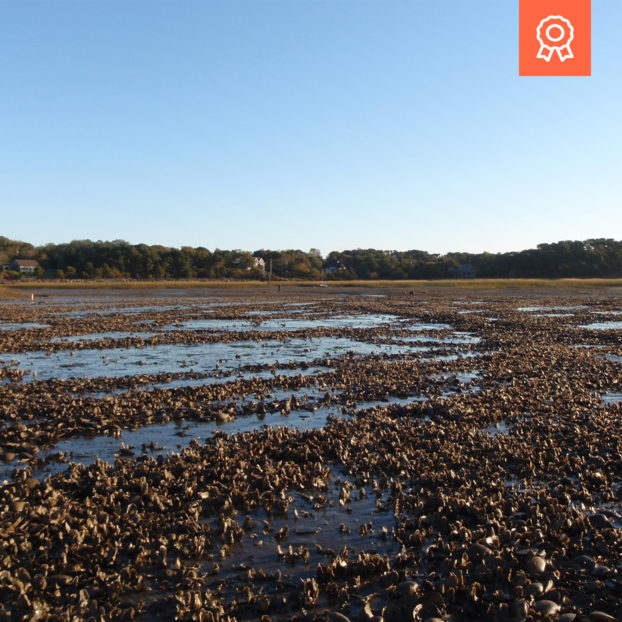Like many towns on Cape Cod, Wellfleet had very little stormwater infrastructure and no wastewater infrastructure. With Wellfleet Harbor being home to a world-class aquaculture program, as well as one of the only remaining natural oyster populations in New England, the harbor is the life-blood of the community’s shellfishing industry, and its protection and enhancement are paramount.
The balance of protection and enhancement was the key to an entirely new and sustainable model for improving water quality while avoiding high infrastructure costs. With limited federal or state grant programs, sewer system costs have been projected to be as high as $60,000 per lot. Absent the construction grants that funded past infrastructure programs, communities are demanding innovative, affordable, and sustainable alternatives. Unwilling to wait for the Town’s MEP report, with its Total Maximum Daily Load (TMDL) limits for nitrogen, Wellfleet engaged Environmental Partners in June 2011 to undertake its Comprehensive Wastewater Management Plan (CWMP), with the goal of pursuing a natural systems approach to sustaining harbor water quality, including the establishment of a 2-acre, sustainable oyster propagation reef.
Environmental Partners developed the scope and approach for the Town’s CWMP to meet state regulations for wastewater management, including reducing nutrient pollution in Wellfleet Harbor. Environmental Partners calculated the nitrogen load on Wellfleet Harbor from land-based sources and developed a plan to reduce the amount of nitrogen affecting water quality in the harbor. The CWMP highlights the restoration of the natural environment by oyster propagation as a fundamental component of the Town’s plan to manage its water resources.
On Cape Cod, the Massachusetts Estuaries Project (MEP) has shifted regulatory focus towards reducing non-point sources of nutrients (principally nitrogen) that are degrading coastal embayments, and communities are considering costly wastewater and stormwater management systems to reach compliance. However, the nitrogen problem in many estuaries is caused by an imbalance between food sources- nitrogen and phytoplankton populations- and consumers such as healthy shellfish populations. Twenty-five years of academic research have proven that oysters have a significant capacity to filter phytoplankton and other suspended solids from the water, thus removing nitrogen, and incorporating it into their tissue and shells. This full-scale demonstration project was intended to show that restoring sustainable, natural habitats can be done at low cost to correct the nutrient imbalances in coastal estuaries.
When allowed to propagate and sustain growth, the eastern oyster provides multiple eco-services, including buffering erosion forces, filtering 25-50 gallons of seawater per adult oyster per day, removing nutrient-rich plankton, enhancing habitat conditions for eel grass and other organisms, food provisioning for other species (including humans), and providing habitat and foraging grounds for dozens of species.
EP worked closely with the Town to monitor the impact of oyster propagation in water quality in Wellfleet Harbor based on a pilot, or demonstration, project. For the demonstration site, the Town selected a muddy, sparsely populated two-acre intertidal area where Duck Creek enters Wellfleet Harbor. In June 2011, a layer of sea clam shell, or cultch, was spread over the study area by the Wellfleet Shellfish Constable. Cultch is a natural substrate on which pelagic oyster larvae can attach, or “set”, following a natural spawn cycle. The juvenile oysters, or “spat”, then grow into adulthood.
The study area was monitored by Dr. Anamarija Frankic, director of the Green Boston Harbor Project at the University of Massachusetts in Boston. By September 2012, an estimated ten million new oysters were growing on the two-acre study area, and water quality monitoring showed measurable reductions in nitrogen in the cultched area. If protected and sustained, this population is capable of filtering 250-500 million gallons of seawater per day, while capturing 5,000 kilograms of nitrogen in their body mass alone.
With the phenomenal success of this demonstration project, the Town now recycles local oyster shells from the annual Wellfleet OysterFest, and deposits them at the study area to extend the reef. Over two years, ten tons of shell and one million live spat (attached to the shells) have been returned to the harbor to grow and contribute to water quality improvement.
Associated with the oyster reef propagation project, the Town targeted stormwater runoff that flowed unabated into the harbor, and has constructed stormwater treatment/infiltration systems out of sight, beneath the busy waterfront streets. With a grant from the USDA’s Cape Cod Water Resources Restoration Project, the Town constructed a new stormwater collection and infiltration system beneath the busy Commercial Street, which runs along Duck Creek from the Town center to the marina. The new system provides capture for a 1-inch storm from over three acres of pavement, and removes 80% of suspended solids, as well as floatables. The completed project is now contributing to improved water quality in Duck Creek and Wellfleet Harbor.





